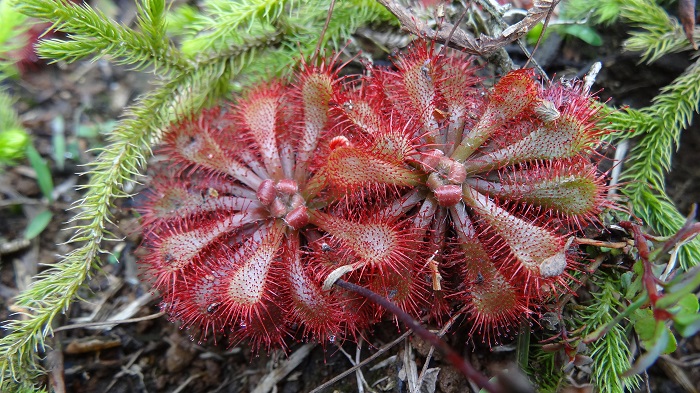
How many carnivorous plants do you know? When asked this question, you will probably answer: Venus flytraps and tropical pitcher plants. But how about when asked how many carnivorous plants native to Taiwan do you know? Many people may not know any. Taiwan has dozens of native carnivorous plants, including sundews, Drosera indica, spoon-leaved sundew and Drosera burmannii of the Drosera genus, and Utricularia aurea, Utricularia gibba, Utricularia caerulea and Utricularia striatula of the Lentibulariaceae family. Several of these species have been listed as endangered, for example, Drosera indica is listed as endangered and Utricularia australis and Utricularia caerulea are listed as critically endangered. These fascinating and intriguing plants are about to disappear before we can truly understand them.
This episode focuses on an important carnivorous plant habitat in the north of Taiwan: Lianhua Temple wetlands in Zhubei, Hsinchu. Four types of carnivorous plants ― spoon-leaved sundew, Drosera burmannii, Drosera indica, and Utricularia caerulea, ― can be found here. This is the only area in Taiwan with a stable population of Drosera indica. Besides the four types of carnivorous plants, the Lianhua Temple wetlands are also home to many endangered or rare companion plants in Taiwan, such as the common philydrum, formosana yelloweyegrass, drooping fimbristylis, Juncellus serotinus, and Murdannia spirata. The area is rich in biodiversity.
The Lianhua Temple wetlands are located close to Lianhua Temple in Zhubei. Geographically, the wetlands are situated in the Fengbiwei mountain range, at the intersection of Zhubei City and Xinfeng Township, which is on the south edge of Hukou Plateau and north edge of the Hsinchu Plains. A valley was formed by the Yangliao River that flows through the area. With the addition of abundant underground water sources, the area became a small swamp. Therefore, many rare carnivorous and aquatic plants inhabits the area. Over 40 years ago, the area surrounding the valley and along the riverbank was covered with many Drosea indica and spoon-leaved sundew plants. Those with basic knowledge related to carnivorous plants can easily spot the plants in the area.
In 1985, Liu Yue-Mei, who was a teacher at National Hsinchu Girls' Senior High school at the time, read about the many carnivorous plants in the Lianhua Temple area. She brought her students to visit the area and indeed found many carnivorous plants, including Drosea indica, Drosera burmannii, and spoon-leaved sundew, with more than 100 plants per square meter. However, this sight did not last long. The water levels in the Lianhua Temple wetlands were decreasing due to the construction of the West Coast Expressway and leisure areas. The construction of check dams also caused sand and mud buildup. Therefore, the effects of the ground sinking became significant. Check dams were constructed to stop the soil coming from upstream to protect the areas downstream. However, check dams also caused sand and mud buildup in the old riverways, transforming the valley from grass wetlands to bushes and forests. Many terrestrial plants invaded the area and caused a crisis of survival for the carnivorous plants.
The Society of Wilderness Hsinchu Chapter was established in 1997, with Liu Yue-Mei acting as the chapter president. A survey in the same year found that the number of carnivorous plants in the Lianhua Temple wetlands was rapidly decreasing. The number of Drosea indica, which once covered the entire area, was reduced to around 50 plants and the number of Drosera burmannii plants was reduced to less than 30. The habitat area for spoon-leaved sundew was also gradually decreasing. Therefore, conservation efforts were implemented. In the following year, the Hsinchu County Government officially commissioned the Society of Wilderness Hsinchu chapter to perform the conservation work. Currently, the Society of Wilderness Hsinchu periodically calculates the number and distribution of carnivorous plants and important companion plants. The chapter organizes working holidays to send volunteers to protect the habitats of the carnivorous plants and remove the abundant grass surrounding the plants. The volunteers performed large-scale grass cutting after the Drosea indica died in the winter. They turned the soil to help Drosea indica seeds flourish. Let us follow Chairperson Liu Yue-Mei of the Society of Wilderness to witness the conservation efforts in Lianhua Temple wetlands and understand the secrets of the carnivorous plants. We will talk about the precious features of the Lianhua Temple wetlands in Zhubei.




 中
中